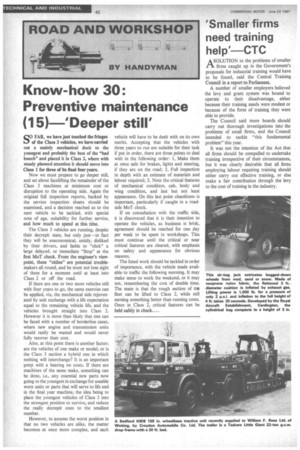Know-how 30: Preventive maintenance (15) 'Deeper still'
Page 44

If you've noticed an error in this article please click here to report it so we can fix it.
QO FAR, we have just touched the fringes I. of the Class 3 vehicles, we have carried out a mainly mechanical dock to the youngest and probably the best of the "bad bunch" and placed it in Class 2, where with steady planned attention it should move into Class 1 for three of its final four years.
Now we must prepare to go deeper still, and set about facelifting the remainder of the Class 3 machines at minimum cost or disruption to the operating side. Again the original full inspection reports, backed by the service inspection sheets should be examined, and a decision reached as to the next vehicle to be tackled, with special note of age, suitability for further service, and how much to spend at this tine.
The Class 3 vehicles are running, despite their decrepit state, but only just—in fact they will be uneconomical, untidy, disliked by their drivers, and liable to "click" a large delayed, or immediate "Stop" at the first MoT check. From the engineer's viewpoint, these "oldies" are potential troublemakers all round, and he must not lose sight of them for a moment until at least into Class 2 or off the road.
If there are one or two more vehicles still with four years to go, the same exercise can be applied, viz, the mechanical side rejuvenated by unit exchange with a life expectation equal to the remaining vehicle life, and the vehicles brought straight into Class 2. However it is more than likely that one can be faced with a number of borderline cases, where new engine and transmission units would really be wasted and would never fully recover their cost.
Also, at this point there is another factor; are the vehicles of one make or model, or is the Class 3 section a hybrid one in which nothing will interchange'? It is an important point with a bearing on costs. If there are machines of the same make, something can be done, i.e., any essential new parts now going to the youngest in exchange for useable worn units or parts that will serve to life end. in the final year machine, the idea being to place the youngest vehicles of Class 3 into the strongest position to survive, and reduce the really decrepit ones to the smallest number.
However, to assume the worst position in that no two vehicles are alike, the matter becomes at once more complex, and each vehicle will have to be dealt with on its own merits. Accepting that the vehicles with three years to run are suitable for their task if put in order, there are three points to deal with in the following order: I, Make them at once safe for brakes, lights and steering, if they are on the road; 2, Full inspection in depth with an estimate of materials and labour required; 3, Note the critical features of mechanical condition, cab, body and wing condition, and last but not least appearance. On this last point cleanliness is important, particularly if caught in a roadside MoT check.
If on consultation with the traffic side, it is discovered that it is their intention to operate the vehicles, as business is brisk, agreement should be reached for one day per week to be spent in workshops. This must continue until the critical or near critical features are cleared, with emphasis on safety and appearance for obvious reasons. • The listed work should be tackled in order of importance, with the vehicle made available to traffic the following morning. It may make sense to work the weekend, or it may not, remembering the cost of double time. The main is that the rough section of the fleet can be lifted to Class 2, while still earning something better than running costs. Once in Class 2, critical features can be held safely in check....












































































































